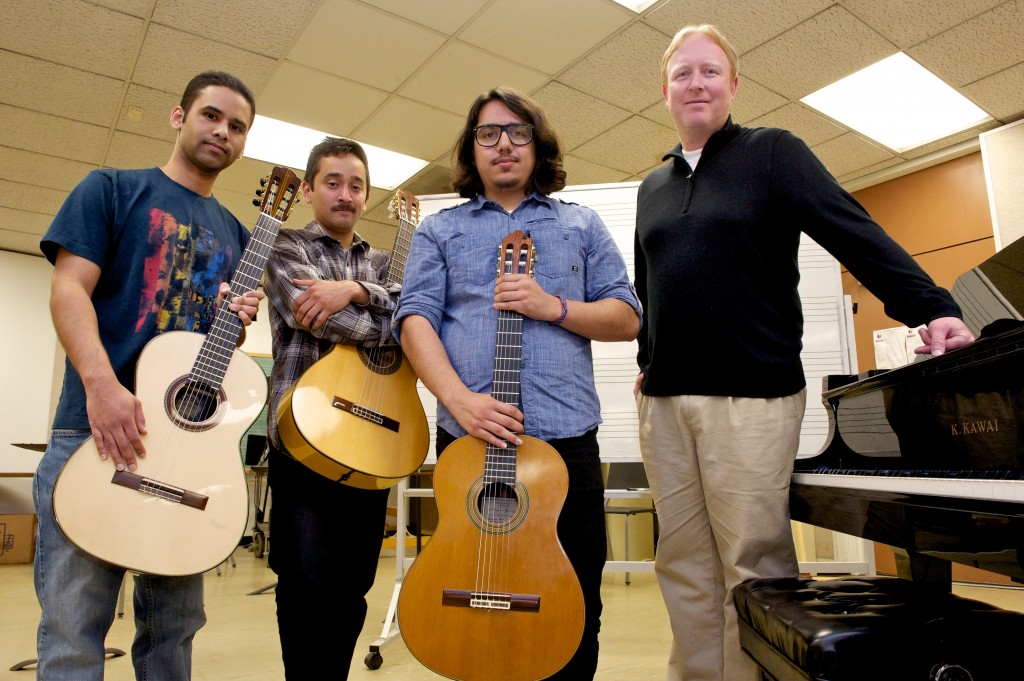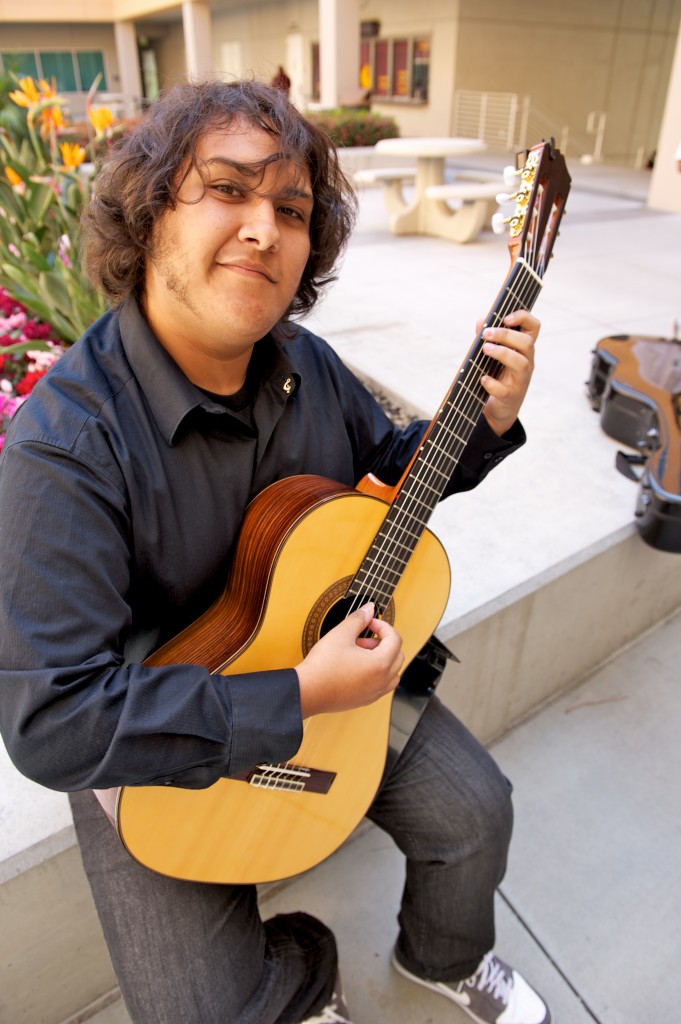
As Graceland is sacred ground for Elvis fans, Shea Stadium was for baseball fans, and the Metropolitan Museum of Art is for art lovers, Guitar Salon International(GSI) in Santa Monica may well be mecca for classical guitarists.
California State University, Dominguez Hills guitar studies students Erick Barrientos, Ivan Chavarria, Jose Gutierrez, and Jan Pequeño did more than visit the renowned center; they performed there. As invited artists to GSI, the students played guitar as part of an ongoing GSI guitar video series posted on YouTube.
GSI is the world’s largest dealer of high-end classical and flamenco guitars, and having the students featured on their website is a major coup in the guitar world, said Scott Morris, music department lecturer and coordinator of the guitar studies program, who arranged the GSI project.
“The purpose for producing and posting the videos is to let people know that we have that level of playing here at the school. I wanted to give the students a semi-professional experience…that could be put up on a YouTube channel that has a built-in guitar audience, so they can get some traction and start to build their careers,” said Morris.
The students, who have all been in the guitar program at CSU Dominguez Hills for at least two years, are keenly aware that their participation in the series, which has nearly 200 videos featuring some of the biggest names in the industry, is an opportunity to develop their professional resumes and to increase their presence beyond the classroom.
“Everybody in the classical guitar world knows what GSI is, and because of that, every classical guitarist [has the potential] to [visit the website and] read about what guitarists at CSUDH are doing, and especially how much Scott Morris is [nurturing] guitarists of the future,” said Gutierrez, a sophomore majoring in music education with an emphasis in classical guitar, who, on a Matsuoka 706 guitar, performed “Etude No. 7” by 20th century Afro-Cuban composer Leo Brouwer.
Student musicians usually practice in a room by themselves or play for an audience that provides instant feedback. So to have a camera pointed at them could have been a little disconcerting, if not a little cold. But, Morris said, the students adapted well to the videotape session while at GSI.
In a blog post the company’s website, Kai Narezo, director of media and marketing at GSI and producer of the videos, said of the students, “I was impressed not only with their playing, but with how quickly they took to playing for a camera, and I think everyone, including the demanding Dr. Morris, was pretty happy with the results.”
Performing is an important component of the overall learning experience for student musicians, which is why Morris said he likes to provide opportunities for his students to perform as much as possible.
“Every time you perform, you learn something. All of the theory, talking about performance, reading books about performance, all the private lessons–none of that really means anything if you can’t get up on stage and play for an audience,” said Morris, who is an accomplished performer, composer and author.
Even though most performers deal with being nervous, the students found a way to remain calm and concentrate on their art.
“When it comes down to playing in front of a camera or in front of people, you really have to know your stuff. Practicing and playing something I felt confident about really helped conquer the nerves,” said Chavarria, a junior music education major who played “Mazurka-Choro” by 20th century Brazilian composer Heitor Villa Lobos, on a spruce Ramirez 125 Años (125-year-old) guitar. “As a student we’re learning that you have to just get into the music. You can’t let a voice be in your head. Concentrating on what I’m doing, with the music phrasing and all that, helps with not being distracted about being at Guitar Salon, in front of a camera.”
Chavarria said the visit at GSI was more than a videotape session; it was also about being and performing in the very room where classical guitar greats have also played.
“I went to go see a guitarist Marc Teicholz there, and now a few months later, I’m there making a video. It’s just great,” said Chavarria. “For somebody like me, who wants to learn and play the classical guitar and teach, and be out there, I know the value of being in the video.”
Before videotaping began, the guitarists, who were the first undergraduate students to be featured in the GSI series, met with another thrill–the guitars themselves. Barrientos, a junior majoring in classical guitar music performance, said the students spent a few hours browsing the appointment-only showroom, sampling guitars of different types, makes, and wood, each producing their unique sound, in order to select the one that would work best for the piece they would each play.
“Kai had 10 or 12 guitars laid out for us to choose from, and there were walls full of guitars,” said Barrientos, adding that Narezo told the students, “’Pick the one you like…’” Barrientos picked a Conde Hermanos AC23 guitar to play “Koyunbaba,”a piece by Italian composer Carlo Domeniconi.
The students selected the music they would perform as carefully as they selected which guitar they would play. The pieces needed to be appealing to the average GSI customer–an amateur guitar player who is familiar with the standards and popular composers–in order to get them to click on the links that would take them to the videos posted on YouTube, said Morris who himself is featured on the GSI YouTube video series, in a set of instructional videos to go along with his 2010 book, “Classical Guitar Complete: from Basics to Bach.”
“What makes someone click on a link? It’s not because they want to hear guitar,” he said. “They could click on a lot of guitar links. If they don’t know your name then there’s no incentive there, but if they are interested in the piece you’re playing, then you’ve got ’em.”
Going with this tactic, senior music performance major Pequeño chose to perform, on a 2011 Lucas Martin guitar, a highly popular piece familiar to anyone who studies guitar, “Prelude No. 4” by Heitor Villa Lobos, on a 2011 Lucas Martin guitar. But he kept in mind that he needed his performance to be distinctive.
“There are hundreds of people who have performed it, but everybody will perform it a little different, adding their own spice. I have to stand out somehow,” said Pequeño, who later posted the video to a guitar forum and received positive feedback from forum participants who said they appreciated the quality of the performances.
Morris said YouTube has become a legitimate tool that professional musicians can use to self-publish their work, avoiding the creative control that record label companies often impose and overcoming the lack of physical music stores.
“It’s never been a better time to be an independent musician. To be in a non-mainstream musical genre like classical or jazz, you don’t need a record label or a big-time agent or publicist,” Morris said.

It also seems to be a good time to be a guitarist at CSU Dominguez Hills. The guitar program, which the late professor of music Rod Butler began in 2004 with only three students, now has about 30 full-time music majors who declare guitar as their primary instrument. Morris said it has been so successful that this semester he hired Los Angeles Guitar Quartet member and Grammy Award winner Matt Greif to teach jazz guitar, as a complement to classical guitar, which Morris teaches.
Because of the high-level of talent now in the program and the high standards set by the faculty, students interested in becoming a part of the program must pass an audition. The number of auditions varies from semester to semester, but this upcoming fall Morris is expecting to hear about a dozen audition performances, out of which he anticipates seven or eight will make the cut.
Prospective students learn about the university’s guitar program through word-of-mouth and outreach efforts. Morris and Greif play at local and national conferences and festivals where they are exposed to potential students. The two instructors also visit area high schools, community colleges, and universities to serve as judges in competitions, and to sing the praises of the CSU Dominguez Hills guitar program.
Morris said the guitar program at CSU Dominguez Hills considered one of the best programs on the west coast and respected nationally, now has a full curriculum including a weekly performance class, guitar ensemble, beginning and intermediate guitar classes, and individual lessons.
For more information on GSI and the student videos, visit: www.guitarsalon.com.
For more information on the guitar program, contact Morris at ssmorris@csudh.edu, and to learn more about the CSU Dominguez Hills Music Department, visit: cah.csudh.edu/music.